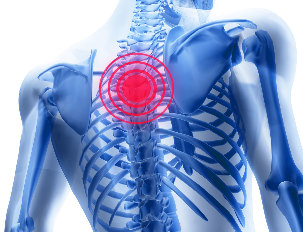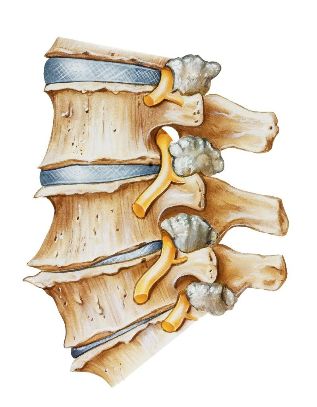The thorax, the low back pain is a chronic disease, which is based on a degenerate-dystrophic defeat intervertebral cartilaginous disks, which leads to make changes on the part of the vertebral bodies and of those around them, of the soft tissues. The disease is widely prevalent and mostly affects people over working age (25-45 years).
Thoracic osteochondrosis meeting much less frequently than lumbar or cervical. This can be explained by the fact that this division of the spine occur less static and motor load than others. However, the osteochondrosis of the thoracic spine is much more difficult to diagnose because it is, in most cases, a leak, simulating a disease of the lungs, the heart, the organs of the upper division of the digestive system.

Causes and risk factors
At the present time, the exact cause of development of breast degenerative disc disease are not installed. The specialists invited to a set of theories (infectious, allergic, hereditary, manual, hormonal, vascular), but none of them does not give a full explanation of the pathological changes occurring in the vertebral column and leading to degeneration of tissues. Probably in the pathological mechanism of development of breast degenerative disc disease participated simultaneously to several different factors. But the main value belongs to a long-static-dynamic overload vertebral segment.
The causes of such overloads are:
- abnormalities of the structure of the spine;
- the asymmetrical arrangement of joint cracks in the intervertebral joints;
- a narrowing congenital spinal canal;
- spondylogenic muscle (myofascial, diffuse) and/or somatic (diffuse, occurring in a number of diseases of the blood vessels and internal organs) pain;
- long-term effects on the spine of vibration, for example, the drivers of the vehicles;
- the physical stress;
- obesity;
- smoking;
- the sedentary lifestyle (lack of exercise);
- the psycho-social factors.
The mobility of the spine is provided by intervertebral discs, which also play and padding role. In their centre lies an elastic jelly-like nucleus, which in a large number of water. Osteochondrosis of the nucleus begins to lose water as a result of the demineralization of polysaccharides. With time, the nucleus is flattened, and with it flattened him and the intervertebral disc protrudes up. Under the influence of the mechanical load of a fibrotic ring of bulges, this process is called a parish priest. Later in the disc, cracks appear, and falling of the fragments of jelly-like kernel, which is the formation of a herniated disc.

The decrease of the height of the disk leads to an approximation of adjacent vertebrae, to the violation of the anatomy of the facet joints. This launches the reactance of the inflammation in the facet surrounding the joints and soft tissues. In addition, the approximation of the vertebral bodies is accompanied by a sprain of the joint capsule, and hit a segment of the spine becomes unstable. The body of the vertebrae to receive the excess of mobility, which may be the cause of damage to the spinal roots and the root development of the chikungunya virus.
On the bottom of the breast-feeding of the degenerative disease of the disk extends gradually the bone tissue of the vertebrae and form bone vyrosty (osteophytes). They may also cause nerve root or compression syndrome myelopathy (spinal cord compression).
Classification
The basis of the classification of breastfeeding degenerative disc disease is posindromnoy principle. Depending on what nerve education dead of the structure of the spine have a impact secrete the syndromes of the following:
- compression as a function of its development is the tension, the deformation or compression of the nerve root, the phase of the spinal cord or a blood vessel, according to this develop, vascular, or syndrome root canal;
- the reflex related to reflex tension innervated by muscles, degenerative and vascular;
- bioadaptive.
The symptoms of breastfeeding degenerative disc disease
The main characteristic of the feeding of the degenerative disc disease is pain. In most cases, she wears dumb moderate.
Long irritation of spinal roots is the cause of disorders of the innervation of the internal organs. Depending on the level of the lesion, the chest, the low back pain can take place under the mask of disease somatic:
| The level of defeat | Innervated by organs | The clinical symptoms of the |
| C7-Th1 | Of the hand, the wrist, the palm of the hands, the trachea, the esophagus | Pain in the arms and palms of the hands, the bronchial asthma |
| Th2 Cells, Th3 | The heart, the pericardium, board of trustees of the coronary arteries | Coronary artery disease, arrhythmias, |
| Th4-Th5 | The bronchi, lungs, pleura, breasts, nipples | Bronchitis, pneumonia, pleurisy>[!@#$], bronchial asthma |
| Th5-Th6 | Bile duct, the gallbladder | Cholelithiasis, the violation of the procedure of assimilation of fats |
| Th6-Th7 | The liver, the solar plexus | Violations of the functions of the liver |
| Th7-Th8 | The stomach | Dyspepsia, gastritis, gastric ulcer and duodenal ulcer |
| Th8-Th9 | The duodenum, the pancreas | The disorders of digestion and of the chair, duodenitis, pancreatitis |
| Th9-Th10 | The spleen, and the diaphragm | The hiccups, the violations |
| Th10-Th11 | The adrenal glands | Allergic reactions, decreased immunity |
| Th11-Th12 | The kidneys | Pyelonephritis, urolithiasis |
| Th12-L1 | The kidneys and ureters | Urinary disorders |
In this regard, the most common symptoms of breast degenerative disc disease are the following:
- the pain in the region of the chest (behind the sternum, in the side, back, in intercostal between the two) – can be both sharp and aching, obtuse; often radiating to the arm;
- pain in the epigastric region – occur regardless of the nature of the offer, the characteristics of the power are often combined with heartburn, nausea, vomiting;
- the pain in the area of the right hypochondrium, are reinforced during the change of the position of the patient's body, sneezing, cough;
- the pain in the lumbar region – simulate an attack of renal colic, often combined with dysuric disorders.

During the compression of the nerve root in a patient with osteochondrosis develops a crisis intercostal neuralgia. For him, characterized by the appearance of acute pain in one half of the rib cage (torakalgiya). The sensation of the pain a bad sign, the character, and distributed in the course of one of the intercostal nerves are the spine to the sternum. Patients describe it as "a shot of electric current" or "back pain". The pain may give to the epigastric region, retrosternal area, the scapula, the arm, and combined with other symptoms (local hyperhidrosis, pallor or redness of the skin), related to the defeat of fibres postganglionic intercostal nerve.
For intercostal neuralgia are features of the pain paroxysms, lasting from a few seconds to a few minutes. In a crisis of pain, economic unbearable. Trying in some way to improve their condition, the patient may freeze in a certain position of the body, avoiding the breathing, the coughing, the sneezing, the twists and turns.
Outside of the attack of pain in the patients report paresthesias (subjective violation of skin sensitivity in the form of crawling, tingling, tickling, pricking with needles in the course of the intercostal space.
The diagnosis
The diagnosis of breast degenerative disc disease is carried out on the basis of the data of the physical examination of the patient, laboratory and tool investigation, including:
- a common analysis of a blood (a moderate leukocytosis, increased erythrocyte SEDIMENTATION rate);
- serum electrolytes (decrease in the rate of calcium);
- an analysis of urine;
- the biochemical analysis of blood;
- the chest x-ray of the spine (detected flattening of the intervertebral disc, the deformation of the disks tel adjacent vertebrae, change tel categories vertebrae relative to another);
- scintigraphy of the spine (identifies the process of the bone mineralization of the vertebrae);
- myelography;
- computer and magnetic resonance, tomography.
The thorax, the low back pain requires a differential diagnosis with the diseases and pathological states:
- dishormonal spondylopathy;
- spondylolisthesis;
- the inflammatory processes;
- ankylosing spondylitis;
- osteomyelitis of the spine;
- rheumatoid arthritis;
- neo-plastic early process (metastases or institute primary chest);
- the diseases of the spine;
- diseases of the gastrointestinal tract (chronic pancreatitis, ulcer of stomach and duodenum, diverticulitis, irritable bowel syndrome (ibs);
- diseases of the genito-urinary tract (urolithiasis, pyelonephritis);
- cardiovascular diseases (coronary heart disease, arrhythmia).

The treatment of breast degenerative disc disease
The treatment of the feeding of the degenerative disc disease is performed as an outpatient procedure. When expressed in pain syndrome of the patient on 2-3 days of prescribed bed rest. Shows the strength of the victim of a segment of the spine, which helps to eliminate compression of the nerve root and thus cutting out the pain syndrome. When expressed in pain syndrome spend the infiltration of the soft tissues of the 2% solution of novocaïne. A short course can be assigned to a non-steroidal anti-inflammatory.
In the scheme of comprehensive treatment of breast degenerative disc disease are also included:
- antihistamines;
- the vitamins of the group;
- tranquilizers;
- acupuncture;
- massage;
- the manual therapy.
After the improvement of the condition of the patient undergoing physiotherapy sessions. The regular execution of a physical exercise with osteochondrosis contributes to the formation of well-developed corset muscle, which helps keep the spine in the correct physiological position, eliminates excess static charge.
Of great importance in the treatment of breast degenerative disc disease is relegated to the regular moderate physical activity (swimming, yoga, tai-chi), the normalization of body weight. Jumping, running, lifting heavy objects and other sports with high loads on the spine are contra-indicated.
The surgical treatment of breast degenerative disc disease shows that in the case of a significant compression of the spinal chord. In such cases, according to the instructions perform:
- the stabilization of the vertebral segment;
- the replacement of the farms of the artificial disc implant;
- laser reconstruction of the disk;
- puncture of the vaporization farms drive;
- microdiscectomy.
The possible consequences and complications
Long of the irritation or compression of a nerve root can cause the development of somatic diseases organs of the thorax, the upper division of the digestive system, the kidneys. The greatest danger of chest, the osteochondrosis is for the myocardium.
The consequences of breastfeeding as degenerative disc disease, can cause diseases of the esophagus, stomach, duodenum, pancreas, gall bladder, lung, training, intervertebral hernia.
Forecast
The thorax, the low back pain is characterized by undulating current, in which the remission are accompanied by exacerbations. With the time, started the treatment, respect for the patient of all recommendations of the doctor, everything related to the treatment of the disease, and lifestyle changes, the prognosis is favorable.
Prevention
The prevention of the feeding of the degenerative disease of disc includes:
- the normalization of the mass of the body;
- smoking cessation;
- living an active lifestyle.

































